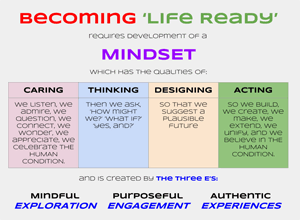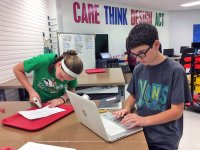Middle School Maker Journey: The Making of a Mantra
In part eight of his year-long series, Kevin Jarrett reveals the power of a four-word design thinking mantra dominating the wall of his middle-school makerspace.
Your content has been saved!
Go to My Saved Content.Care. Think. Design. Act. These words are the first thing that people see when entering Digital Shop, our middle school makerspace. This mantra anchors the threshold experience, a visitor's first visual impression of the space.
But what do the words really mean, individually and collectively? Why those words, in that order? And how do they resonate with our learners and with my colleagues in regard to their impressions of the program?
In the Beginning. . .
In July 2015, we visioned our program during a design charrette with the help of designer/consultant David Jakes. The latter part of that day involved synthesizing an entire morning’s worth of ideas into our Manifesto or credo -- what we do and why we do it. As we summarized the day's thoughts into a coherent whole, four crucial concepts became clear amid all the post-its, stickers, and scribblings on bulletin board paper:
- We wanted our kids to care about problems they see in the world, acknowledging our desire to have empathy become the anchoring force in our learning community.
- We wanted our kids to think deeply about the problems, coming to an understanding of what each problem really is.
- We wanted them to use their creativity and imagination to design something (an object, process, or system) that could solve the problem.
- We wanted them to act toward putting their design into production, whether that meant creating a physical prototype to present or a behavior that they or others can exhibit.
With that as guidance, our manifesto came to life:
- Caring: We listen, we admire, we question, we connect, we wonder, we appreciate, we celebrate The Human Condition.
- Thinking: Then we ask, "How might we?" "What if?" "Yes, and?" . . .
- Designing: . . . so that we suggest a plausible future.
- Acting: . . . so that we build, create, make, extend, unify, and believe in The Human Condition.

And thus, our mantra was born: "Care. Think. Design. Act." When I approached my friend and colleague Monica Keenan (also mom to an NCS eighth-grade student) about painting the words on a wall in my space, she suggested vinyl decals from Do It Yourself Lettering. We quickly chose the font, colors, and size we wanted, placed the order, and within about a week had our four giant decals ready for installation.
Reaction Time
With the space completed, all that was left was to see the impression that it made on visitors. Kids were the first to see it. I recall overhearing a few of them read the words aloud as they entered the room. We felt the meaning would be intuitively obvious to a casual observer because the beauty of the mantra is its simplicity. But would students make the connection between all four words to see the larger picture, the importance of empathy, and how the mantra (and the larger Manifesto) was a call to action, not just a handy slogan? Would they get it?
Yes, they would -- and none more so than Isabelle V., a sixth-grade student who, with nothing more than an assignment to "create an iMovie trailer," made this terrific one-minute tribute to our program, how it impacts her, and how it and she will change the world.
But wait, there's more! We're currently in the midst of our third Design Experience (DE.3), The Weather Challenge. Winter storm Jonas hit our area in January 2016. Though we did not get as much snow as surrounding areas, it was still a major event, providing the perfect context for a lesson on design thinking, and a field test of the mantra. (Special thanks to Mary Cantwell for the idea.) Kids are being challenged to explore the impact of the recent severe weather, both negatively (injuries/deaths, property damage, disruption to pets or wildlife) and positively (recreational opportunities, time off school, time to spend with family), to come up with inventions that solved problems or made life better. So far, students have come up with:
- Automated snow shovels, for those who "love snow but hate shoveling"
- Buildings that automatically raise during floods
- A special helmet for autistic kids to wear during storms that helps calm them with images projected onto special goggles
- A drone-operated snow plow
In every situation, students had to care about a problem or issue, think how they might solve the problem, design a solution, and then act on or create it.
Parents Weigh In
While students are primarily served by our program, they're not the only ones to see and experience the magic. Our mantra is an equal-opportunity inspirer. Everyone can care, think, design, and act -- it's about empowerment, contributing to the greater good, and changing the world. Here's what some parents are saying:
Staff Has Their Say
A seventh-grade teacher observes:
One middle-school specials teacher declares:
Another seventh-grade teacher adds:
Student Voices
And let's hear from the students themselves. One sixth-grade boy says:
A seventh-grade girl tells us:
An eighth-grade boy admits:
And this, from another seventh-grade girl:
So there you have it. It's hard to believe that four words, plastered on the wall in giant letters, can make such an impact -- or maybe it’s not that hard. In our program, design thinking is the engine, passion and imagination are the fuel, and creativity and innovation are the exhaust. We've got the pedal to the metal, and we’re having the time of our lives!
If you don't have a program like this in your school, getting one started might be easier than you think. Gather your stakeholders, dream big, come up with a manifesto to guide you, and invest in the space, the program, and the kids. You'll be glad you did!
